The Million Dollar Dress
Tips and tricks.
The Million Dollar Dress
The Infinity dress Learn how :
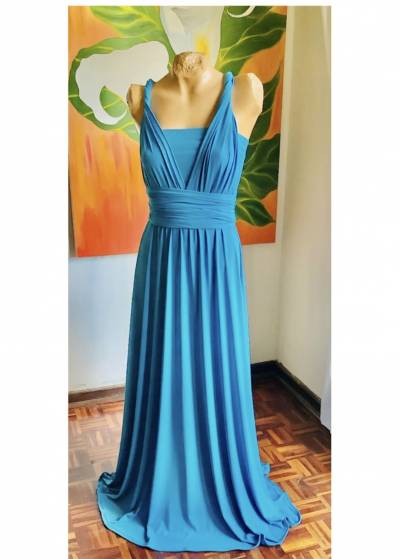
Video
- To draft a pattern for an infinity dress in a variety of sizes
- Why this dress is called the million dollar dress
- Which fabric is the best to use for maximum profit and customer satisfaction.
- Tools and techniques used by manufacturers to optimize production and profit
- How to price your product
- Where to sell your product
- How to advertise your product
- Best packaging techniques
- Best practices and tips
The dress
Preferred by bridesmaids across the globe because of its versatility, you’ll discover that this style is much sort after and that every order you receive will probably be for multiple garments. The dress can also be worn as a prom dress, evening outfit or even as a wedding dress. Yes! It’s that versatile.
Drafting considerations
Basically, an infinity dress is a skirt, either circle or A-line with long straps attached and an easy fit elastic waist.
The size that you’ll learn to make here can easily be graded to accommodate individual measurements or standard sizing.
Standard sizing :
XSmall :
Waist to fold for back and front = 19cm
Strap width = 28cm by 2.5m (2500cm)
Waist band = 77cm
Small :
Waist to fold for back and front = 20cm
Strap width = 30cm by 2.5m (2500cm)
Waist band = 81cm
Medium :
Waist to fold for back and front = 21cm
Strap width = 31cm by 2.5m (2500cm)
Waist band = 85cm
Large :
Waist to fold for back and front = 22cm
Strap width = 32cm by 2.5m (2500cm)
Waist band = 89cm
XLarge :
Waist to fold for back and front = 23cm
Strap width = 34cm by 2.5m (2500cm)
Waist band = 93cm
For +plus sizes add 2.5cm/size to the strap and 1.5cm to the side of the skirt and waist. So, it’s 1.5cm times 4 for the waist band.
Fabric :
Cost effective fabrics to choose are :
Bon Bon ( best choice)
Viscose Lycra (tends to be transparent)
Trilobal (tends to ladder from one side)
Stretch mesh lined with Trilobal
It’s best to allocate about 4.5m of fabric for each dress. Generally, each order will be for 3-5 dresses so you’ll be buying a minimum of 13.5m at a time. Find a supplier who offers a discount on your fabric of choice if you buy more than 10m at a time.
Notions:
Elastic. Use only knitted elastic since it tends to stretch better with the fabric and roll far less.
Polyester sewing thread. Buy 5000m spools
Equipment:
Overlocking machine (Serger). Preferably an industrial machine
Plain sewing machine that offers stretch stitching
Good quality scissors
Spunbon for making patterns
Tailors chalk
Shirt hook tape
Nipper (thread cutter)
Cutting table
Packaging equipment (see packaging below)
Drafting the pattern

Complete the following steps:
Step 1

Draw a rectangle 110cm by 66cm. This rectangle “holds” the pattern. This is for a size XSmall and you can adjust the measurements accordingly.
Step 2
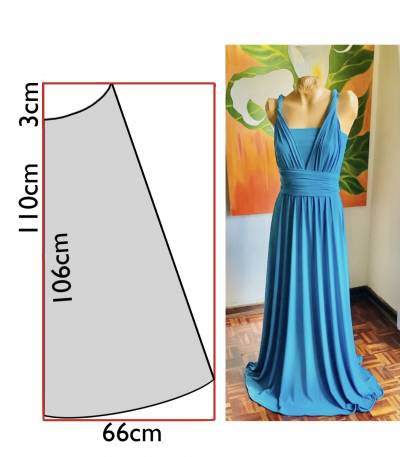
3cm from the top line mark out the center-front line at 106cm this is the length skirt of the dress as measured from the waist. If you want the garment shorter, you can adjust the length.
Step 3
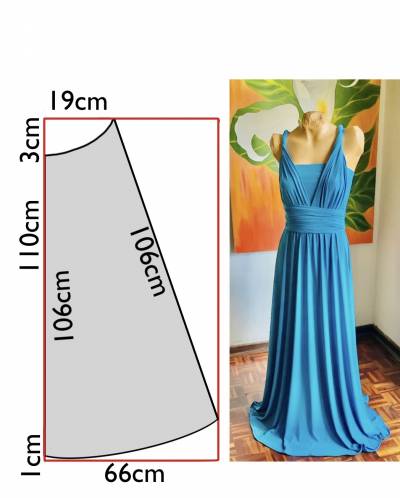
Mark a point 19cm from the center-front on the top line of the rectangle.
Draw in a gentle curve from the center-front top point to this point. This is the waistline.
Step 4
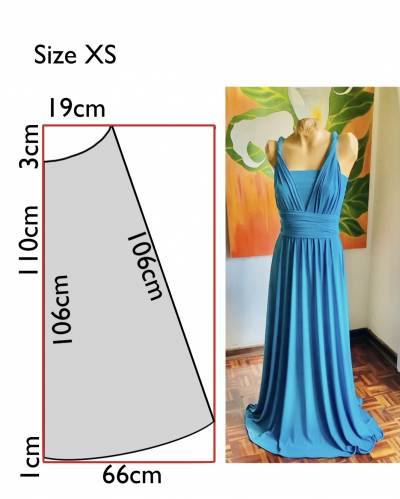
Mark a point at 66cm on the base of the rectangle. Draw a straight line from the 19cm waistline to a point app 15cm above the baseline for the side-seam. This line should be 106cm in length.
Step 5
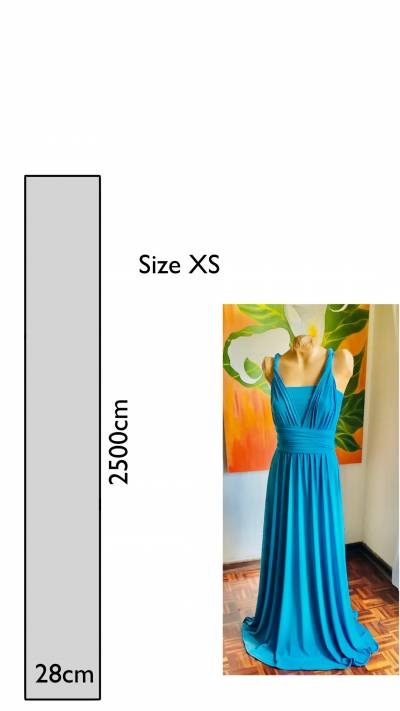
Draw in the hem curve from the base of the center-front to the base of the side-seam curving it down by 1cm to meet the base of the rectangle at a point 15cm from the center-front continue to side-seam.
Step 6

The infinity strap for this size is 2.5m long by 28cm wide. Angle the bottom of the strap that attaches to the skirt at 4cm to nothing. The 4cm shorter length is the outside of the strap. The straps are crossed over by 5cm when attached to the skirt.
Step 7

The waistband is 77cm by twice the width of the elastic, plus seam allowance.
Cutting the pattern

Cutting your pattern
Lay the fabric on the fold and cut 2 skirt sections to the fold, 2 boobtube sections to the fold. Cut 2 straps 2.5 meters long in the width for the desired size:
Elastic
The rule that works here is to cut the elastic (the 5cm wide version) at 8cm less than the waist size.
Sewing
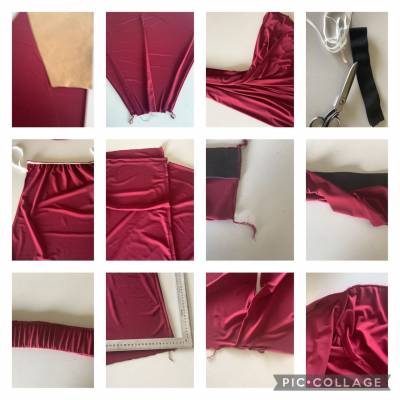
- Stitch skirt together at side seams using 6mm seam allowance. Preferably using an overlocker.
- Overclock the sides and top of the straps. Hem the sides and top.
- Neaten hem edge of skirt. Hem at 1.5cm
- Fold waistband in half. Fold elastic in half. Set elastic onto band matching side seam, 1cm from bottom of the raw edge. Stitch together at the side seam.
- Fold band to right side, folding elastic inside. Stretch and stitch elastic to the band.
- Turn the skirt inside out. Mark centre front with a notch.
- Lay the hemmed straps right sides together and cut an angled section off the base - 4cm to nothing. That’s 4cm off the side, the center is the longer section.
- Fold the 2 straps over each other (crossing over by 5-6cm).
- Sew infinity straps to skirt wrong sides together(so that once you’ve added the waistband the straps will lie behind it)
- Turn the ensemble to the right side. Pin the waistband to the skirt section, matching side seam, then quarter the waistband and match to the center front, center back and other side. Stitch waistband to skirt using 6mm seam allowance, easing to fit.
Labels
In order to produce a professional looking product it’s a must to have sew-in labels and swing tags. However, these items can be very expensive to buy because you need to buy in bulk.
Below are a few suggestions to cut the cost of these items :
For labels :
Buy a roll of 2.5cm wide ribbon. Design your label in Canva as a .png file. Take this file to a vinyl printing shop and order 200 prints on one sheet of vinyl. Then, you can cut out the vinyl iron-on as needed and iron it to the ribbon to produce a professional looking sew-in label.
Swing tags
1. Barb swing tag gun
2. Design a swing tag in Canva as a .png file
Take the design to a business card printer that offers a really good price for 500 cards, and order the minimum in black and white. Have the printer print two designs on one card. Cut the cards in half and punch a hole in it for the barb.
Costing the Retail Price of Infinity Dresses
1. Introduction:
The dresses will be produced using sewing machines and electricity, and will be packaged and labeled for sale. The objective of the business is to create high-quality, fashionable dresses and generate a sustainable profit by selling them at competitive retail prices.
2. Business Description:
Our business will focus on sewing dresses for special occasions. The dresses will be made with attention to detail, quality fabrics, and skilled craftsmanship that produces stylish garments.
3. Market Analysis:
Conduct market research to understand pricing of similar dresses in the market. Identify target customer demographics and their buying behavior. Evaluate competitors to determine pricing strategies and points of differentiation.
4. Cost Analysis:
a. Raw Materials: Calculate the cost of fabric, sewing thread, and elastic required to produce one dress. Consider purchasing these materials in bulk to benefit from cost savings.
b. Labor: Factor in the time and effort required to cut, sew, and finish each dress. Determine a fair wage for the labor involved in the production process.
c. Overhead: Include the costs of electricity, maintenance of sewing machines, packaging materials, and labels.
d. Packaging and Labeling: Determine the cost of packaging materials and labels required for each dress.
5. Pricing Strategy:
Using the cost analysis, determine the total cost of producing one dress. Decide on a suitable profit margin to cover business expenses and generate a reasonable profit. Set a competitive retail price that aligns with market trends and customer perceptions of value.
6. Distribution:
Decide on the distribution channels for your dresses. Consider selling through your website, partnering with local boutiques, or utilizing online marketplaces like Etsy or Amazon Handmade.
7. Quality Control:
Ensure consistent quality by implementing quality control measures throughout the production process. Check for any defects in the raw materials, monitor the sewing process, and inspect finished dresses for any flaws.
8. Financial Projections:
Create financial projections based on estimated sales volume, production costs, and pricing. Monitor actual performance against projections regularly and adjust the business strategy accordingly.
9. Scalability:
Plan for the future scalability of your business. Consider hiring additional labor, expanding production capacity, or introducing new dress designs as the business grows.
Marketing suggestions:
1. Create a Compelling Website:
Set up a simple and visually appealing website showcasing your dress, customization options, and contact information. Use platforms like WordPress, Wix, or Squarespace, which offer user-friendly templates and affordable hosting options.
2. Leverage Social Media:
Utilize social media platforms like Instagram, Pinterest, and Facebook to showcase your dresses. Post high-quality images of your creations, customer testimonials, and behind-the-scenes glimpses of the dress-making process. Engage with your followers, respond to comments, and use relevant hashtags to reach a broader audience.
3. Collaborate with Wedding Planners and Photographers:
Build partnerships with local wedding planners and photographers. Offer them incentives, such as discounted dresses for styled photo shoots or commission on referrals. This way, you tap into their network and gain exposure to potential brides.
4. Blogger and Influencer Outreach:
Identify fashion and wedding bloggers or influencers who resonate with your target audience. Offer them a dress in exchange for an honest review or a feature on their platform. This can significantly boost your brand visibility.
5. Email Marketing:
Start building an email list by offering a discount or freebie to bridesmaids who sign up. Use email marketing tools like Mailchimp or Sendinblue to send out newsletters showcasing your latest designs, promotions, and updates.
6. Local Bridal Shows and Events:
Participate in local bridal shows, craft fairs, or wedding events. Display your dresses, offer exclusive discounts to event attendees, and collect contact information for potential clients.
7. Referral Program:
Implement a referral program where satisfied customers can refer their friends and family in exchange for a discount on their next purchase. Word-of-mouth marketing is powerful and cost-effective.
8. YouTube Tutorials:
Create simple DIY videos demonstrating sewing tips or dress styling ideas. This positions you as an expert in the field and helps build trust with your audience.
9. Collaborate with Local Bridal Shops:
Reach out to local bridal boutiques and ask if theyd be interested in showcasing your dresses on a consignment basis. This way, you expand your reach without investing heavily in inventory.
10. Online Advertisements:
Consider running targeted online ads on platforms like Facebook or Google Ads. Set a budget limit to control costs and monitor the performance of your ads closely.
11. Take great photos of sample dresses in various lengths and use these pictures to sell on platforms such a Etsy, Facebook Market Place, Amazon Handmade, EBay or similar platforms that exist in your country.
Remember, consistency is key. Stay active on your chosen marketing channels, respond promptly to inquiries, and consistently deliver high-quality dresses and customer service. Over time, your reputation will grow, leading to increased sales and referrals.